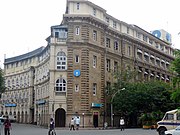State planning and the mixed economy

After independence, India opted for a centrally planned economy to try to achieve an effective and equitable allocation of national resources and balanced economic development. The process of formulation and direction of the Five-Year Plans is carried out by the Planning Commission, headed by the Prime Minister of India as its chairperson.
India's mixed economy combines features of both capitalist market economy and the socialist planned economy, but has shifted more towards the former over the past decade. The public sector generally covers areas which are deemed too important or not profitable enough to leave to the market, including such services as the railways and postal system. Since independence, there have been phases of nationalizing such areas as banking. More recently, there have been phases of privatizing such sectors.
Public expenditure

India's public expenditure is classified as development expenditure, comprising central plan expenditure and central assistance and non-development expenditures; these categories can each be divided into capital expenditure and revenue expenditure. Central plan expenditure is allocated to development schemes outlined in the plans of the central government and public sector undertakings; central assistance refers to financial assistance and developmental loans given for plans of the state governments and union territories. Non-development capital expenditure comprises capital defense expenditure, loans to public enterprises, states and union territories and foreign governments, while non-development revenue expenditure comprises revenue defence expenditure, administrative expenditure, subsidies, debt relief to farmers, postal deficit, pensions, social and economic services (education, health, agriculture, science and technology), grants to states and union territories and foreign governments.
India's non-development revenue expenditure has increased nearly fivefold in 2003–04 since 1990–91 and more than tenfold since 1985–1986. Interest payments are the single largest item of expenditure and accounted for more than 40% of the total non development expenditure in the 2003–04 budget. Defence expenditure increased fourfold during the same period and has been increasing due to India's desire to project its military prowess beyond South Asia. In 2007, India's defence spending stood at US$26.5 billion. Administrative expenses are compounded by a large salary and pension bill, which rises periodically due to revisions in wages, dearness allowance etc. subsidies on food, fertilizers, education and petroleum and other merit and non-merit subsidies account are not only continuously rising, especially because of rising crude oil and food prices, but are also harder to rein in, because of political compulsions.
Public receipts

India has a three-tier tax structure, wherein the constitution empowers the union government to levy income tax, tax on capital transactions (wealth tax, inheritance tax), sales tax, service tax, customs and excise duties and the state governments to levy sales tax on intrastate sale of goods, tax on entertainment and professions, excise duties on manufacture of alcohol, stamp duties on transfer of property and collect land revenue (levy on land owned). The local governments are empowered by the state government to levy property tax and charge users for public utilities like water supply, sewage etc.[39][40] More than half of the revenues of the union and state governments come from taxes, of which half come from Indirect taxes. More than a quarter of the union government's tax revenues is shared with the state governments.
The tax reforms, initiated in 1991, have sought to rationalise the tax structure and increase compliance by taking steps in the following directions:
- Reducing the rates of individual and corporate income taxes, excises, customs and making it more progressive
- Reducing exemptions and concessions
- Simplification of laws and procedures
- Introduction of permanent account number (PAN) to track monetary transactions
- 21 of the 29 states introduced value added tax (VAT) on April 1, 2005 to replace the complex and multiple sales tax system[40][42]
The non-tax revenues of the central government come from fiscal services, interest receipts, public sector dividends, etc., while the non-tax revenues of the States are grants from the central government, interest receipts, dividends and income from general, economic and social services.
Inter-State share in the federal tax pool is decided by the recommendations of the Finance Commission to the President.
Total tax receipts of Centre & State amount to approximately 18% of national GDP. This compares to a figure of 37-45% in the OECD and explains why the country remains under-developed as evident inter-alia from the poor state of its infrastructure and social services compared to OECD countries. The limited resources of Government affect its ability to pay fair wages to public servants. This may well be the cause of of endemic corruption at all levels of government.
General budget
The Finance minister of India presents the annual union budget in the Parliament on the last working day of February. The budget has to be passed by the Lok Sabha before it can come into effect on April 1, the start of India's fiscal year. The Union budget is preceded by an economic survey which outlines the broad direction of the budget and the economic performance of the country for the outgoing financial year. This economic survey involves all the various NGOs, women organizations, business people, old people associations etc.
India's union budget for 2005–06, had an estimated outlay of Rs.5,14,344 crores ($118 billion). Earnings from taxes amount to Rs. 2,73,466 crore ($63b). India's fiscal deficit amounts to 4.5% or 1,39,231 crore ($32b). The fiscal deficit is expected to be 3.8% of GDP, by March 2007

No comments:
Post a Comment